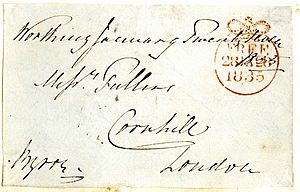Free frank facts for kids
A free frank was a special mark put on letters in Britain. It meant the letter didn't need a postage stamp. This privilege was given to certain important people. These included Members of Parliament (MPs), members of the House of Lords, and some government officials. To use a free frank, the official sender had to sign the letter.
People really wanted these signed letters in the early 1800s. They would cut out the front part of the envelope with the signature for their autograph collections. These cut-out parts are called free fronts by collectors.
In 1840, a man named Rowland Hill made big changes to the British Post Office. He ended the free franking system. This happened when he introduced the first postage stamps in Britain.
Contents
How Free Franks Started and Were Used

The Parliamentary Franking System allowed members of the British Parliament to send letters for free. Taxpayers paid the cost instead. This system began a long time ago, around 1652. Back then, letters "for the service of the Commonwealth" were free.
At first, free letters just had the address, the word Frank or Free, and the sender's signature. Later, special stamps started to be used. This began in Dublin in 1706, then in London and Edinburgh. They also started adding the date the letter was sent.
Why the System Was Abused
The free franking privilege was meant for official government business. However, postage was very expensive back then. So, many people misused the system.
- MPs would sell their franking privilege to businesses.
- They would also frank letters for their friends and family.
Rules were made about how many letters could be sent. There were also rules about how heavy they could be. But these rules didn't stop the abuse of the system.
One person, Ralph Allen, said that in 1741, the value of free letters was over £50,000. By 1764, this value had grown to £170,000 each year. This shows how much money the Post Office was losing.
In 1840, Rowland Hill's reforms stopped this abuse. It was common for MPs to give blank signed papers to friends. Their friends could then write letters on them and mail them for free. Some large companies even put Parliament members on their boards. This was just so their mail could be sent using the free franking privilege.
Even though free franking existed since the mid-1600s, the first special handstamp was used in England in 1764. This was when the Post Office's money went from the King to the government.
In 1764, a law was passed to stop people from misusing the system. It even said that faking a signature to send mail for free could lead to seven years of being sent away. By the 1830s, about five million free franks were used every year. The system finally ended with the start of the Uniform Penny Post in 1840.
Collecting Free Franks
Collectors of stamps and postal history often look for free frank marks. These marks are found on old mail from before stamps were used. People who collect them are called philatelists.
Free Franks Around the World
Other countries also had similar systems. For example, in the United States, members of Congress can send mail for free. They just sign their name, which is called their frank. The term "free frank" is now used for many marks on mail that mean no postage is needed. The U.S. President does not have this privilege. However, the Vice President, as head of the Senate, can use their signature to frank mail.
See also

